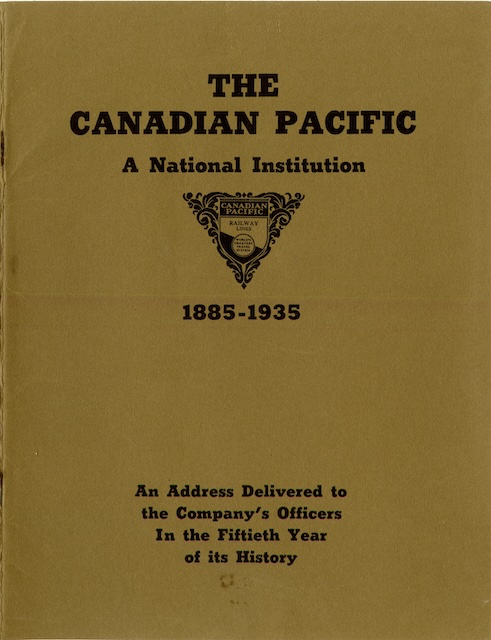“The history of the Canadian Pacific Railway has been termed a tale of gallantry, honesty and steadfastness,” says this booklet. Apparently, the people who built the railway did so solely as part of their patriotic duty to the new confederation of Canada and not to earn profits or enjoy subsidies from the government.
 Click image to download a 11.7-MB PDF of this 20-page booklet.
Click image to download a 11.7-MB PDF of this 20-page booklet.
In order to get British Columbia to join the fledgling nation, the government had to promise to build a transcontinental railway. Grand Trunk, Canada’s largest railroad in 1880, refused to build it saying the costs were too high and the potential returns too small. The government itself tried to build it but ended up spending twice as much as private parties would spend.
It took five courageous men — George Stephen, Duncan McIntyre, Richard B. Angus, John S. Kennedy and James J. Hill — to nobly step up and offer a way out of this quagmire. With “indomitable pluck and determination” they agreed to build the Canadian Pacific for subsidies equal to about half the costs the government was expecting to spend.
Once built, the railway spent $102 million “of its own money” to bring settlers into the West who would farm and manufacture goods that could be shipped by rail. It then supplemented its rail lines with steamships effectively connecting London with Hong Kong and Australia. Canadian Pacific was also the first company in Canada or the United States to make collective bargaining wage agreements with labor unions.
When the Great War began, CP turned its locomotive shops into munitions factories, offered six months wages to any employee who joined the armed forces and promised them their jobs on their return, and further supported the war effort with loans of more than $100 million, “probably the largest contribution made by any one industrial institution in the British Empire.”
Having accomplished all this good work, railway officials were stunned to find themselves demonized by people who claimed that CPR was a “menace to the country’s best interests.” These people were “animated by a distrust that would seem to have no other basis than jealousy and hatred of [the railway’s] success.” Thanks to such attitudes, the government started a competing railway, Canadian National.
“At once the Canadian Pacific Railway was placed in competition with the Canadian government, and, encouraged by political expediency based on the temporary popularity of ‘public ownership’ as a panacea for economic troubles, the new competing railroad set out on its impossibly extravagant course to destroy the position which the Canadian Pacific had been called upon to make for itself in the country’s economic structure.”
Thanks to this movement, “Government resources were squandered in the effort to make the new railway the greatest transportation system on earth, and this with no regard to possible financial returns on investments made or to the amount of business available.” This “threatened the solvency” of Canadian Pacific. When combined with the Depression, “most sensible people saw that something had to be done about it.”
What should be done, Canadian Pacific suggested in the conclusion of this piece, was “unified management of both railways.” Without such unification, the paper warned, it was likely that both companies would fail. Of course, unification never happened.
This is supposed to be an address given to the officers of Canadian Pacific on “the fiftieth anniversary of Canadian Pacific service to Canada.” Although the booklet says it was “prepared by” J. Harry Smith, the manager of CP’s press bureau, it doesn’t actually say that he was the one who gave the speech. In fact, I suspect no such address was actually given, at least in the detail included in this paper.
I understand Canadian Pacific’s political dilemma at the time. However, instead of portraying itself as altruistic, which few would find believable, it might have done better to defend the private enterprise system as being more efficient than government ownership. Nor was unification an appropriate solution: If the unified railway were privately owned, it would still be subject to the criticisms that led to the creation of Canadian National in the first place. If it were publicly owned, it would probably engage in the same wasteful policies that this paper attributed to Canadian National.
It took sixty years, but private enterprise won when the government privatized Canadian National in 1995. Up until then, government favoritism towards its railroad allowed that company to grow larger than Canadian Pacific while it actively stifled Canadian Pacific’s ability to compete in many areas such as with its airline.
The latest chapter in Canadian Pacific’s story is its purchase of Kansas City Southern, which required a fight with Canadian National. Now that the two are playing on something like a level playing field, I wonder how they will look in 2035, the 150th anniversary of CP’s “service to Canada.”
